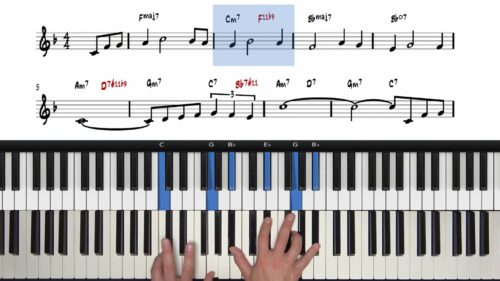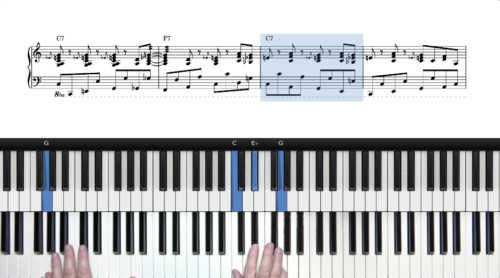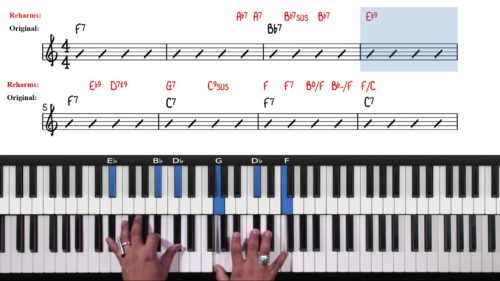Slow Blues Passing Chords
In this lesson we dive into passing chord options when playing slow blues piano. We start by focusing on the transition from the I chord to the IV chord in the 12 bar blues form.
Leading Tones & Passing Tones
In previous lessons we explored the use of leading tones and passing chords a half step above target chords. We’ll now expand our options by approaching the target chord from both a half step above and a half step below, considering additional elements like melody and chord alterations.
The Transition From I to V
We start by focusing on the chord change from I to IV chord and we explore options to create smoother transitions into the Bb7. This involves playing around with chromatic passing chords such as B7 and A7 which create dissonance but resolve beautifully when moving from the I to the IV chord.
An important aspect of this lesson is the consistent use of the note F in the melody over the passing chord options. This creates a synergy with the key and also adds additional colour and texture to our passing chords.
Blues Passing Chord Options
The lesson includes tips and guidance for practicing passing chord options and variations. We emphasise the importance of drilling the transitions in various registers of the piano. This practice will enhance your ability to incorporate passing chords seamlessly into your playing.
We finish with some insights into how these passing chord techniques can be integrated into slow blues improvisation, with references to the content covered in the improvisation module of this course.
Lesson Downloads
-
Chromatic Passing Chords File Type: pdf
Practice Tips
-
Start by isolating the transition between F7 and Bb7 and experiment with the alternate passing chords options (B7 and A7). Pay close attention to the dissonant nature of these chords and how they enhance the resolution into the IV chord Bb7.
-
Isolate and drill the transitions in different registers of the piano. It's important to be familiar with the passing chord inversions for understanding how the same chords can be applied in the lower, middle, and higher octaves.
-
Focus on smooth finger movements and clean chord changes. Once comfortable, increase the tempo gradually while maintaining accuracy and a steady groove.
-
Use the improvisation module as a reference for creating melody lines and then incorporate passing chords spontaneously while improvising. This will help to make these techniques a natural part of your playing.








Hello Hayden,
Thank you for this course.
Will you post .pdfs regarding chapters 4 and 5 ?
Thank you.
Samy
Hi Samy 👋
I have just added a PDF file to this lesson – please take a look and let me know if it’s what you are looking for. It’s a summary of the main passing chord options that we use in this lesson.
I have also added PDF downloads for all of the lessons up to this one, and I will add the rest shortly.
Talk soon,
Hayden